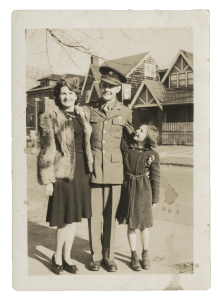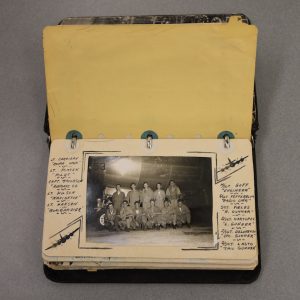Stories Worth Telling: Marking 20 Years of “The Greatest Generation” celebrates those whose sacrifices and contributions during World War II inspired Tom Brokaw’s 1998 book The Greatest Generation. On the book’s 20th anniversary, this exhibit immerses visitors in stories of ordinary people who did extraordinary things. Original papers, artifacts, and photographs document the events leading to World War II, share the experiences of those who fought on foreign and domestic fronts, and reveal the research used to create the bestselling book. Drawing from the collections of the University of Iowa Libraries’ Special Collections and the African American Museum of Iowa, Stories Worth Telling brings to our current moment a generation both familiar and overlooked, offering opportunities to consider what “The Greatest Generation” means today.
Download the Stories Worth Telling exhibition guide (PDF)
America in Transition
“1920 was an auspicious year for a young person to enter the world as an American citizen” (4) .The Roaring Twenties brought an idea of prosperity that seemed without end. Women gained the right to vote, the great experiment known as Prohibition started, and broadcast radio signaled in a new era. Of course there were cracks in this American façade. Not everyone was living with equal rights, organized crime was corrupting large urban areas, and the economy was not as strong as it appeared. By the age of 10, the American born in 1920 was about to enter the Great Depression.
From this crumbling state came Franklin Roosevelt and his New Deal, “declaring to a nation with more than fifteen million people out of work, ‘The only thing we have to fear is fear itself’” (6).
At the same time, Adolf Hitler took office as chancellor of Germany, turning on the Jews and stripping them of rights and voices, while seizing neighboring countries for the Nazi regime.
Those Americans born in 1920, who had seen so much already, found themselves at the frontlines of an impending war.
On December 7, 1941, the Japanese attacked Pearl Harbor. The news went out on the radio, and nothing would ever be the same.
Ordinary People Who Did Extraordinary Things
Taking a page from Brokaw’s The Greatest Generation, this exhibit highlights just some of the stories of people whose everyday lives turned upside down after the start of the war. This small selection of ten men and women, all of whom have an Iowa connection, represent the far-reaching implications of war and what the human spirit can truly accomplish. In the end these are tales of ordinary people, but their stories show just how powerful ordinary people can be.
 |
WWII Military Helmet: Iowa Women’s Archives, Evelyn Crary Bacon Papers, IWA 0012 |
 |
Photograph of Jackson Hyde with family, University of Iowa Libraries Special Collections, Jackson Hyde Papers, MsC 042 |
 |
Ration box: African American Museum of Iowa, Glenwood Tolson Collection |
 |
Photograph of Blanca Vasquez Gaines, Iowa Women’s Archives, Blanca Vasquez Gaines Papers, IWA 0899 |
 |
Allen Goff notebook featuring photograph of “Jake’s Jalopy” crew: Special Collections, Allen Goff World War II Collection, MsC 1126 |
Writing About a Generation
In the spring of 1984, Tom Brokaw went to Normandy, France to work on an NBC documentary on the 40th anniversary of D-Day. While on assignment, Brokaw met with several veterans and listened to their stories. It was on the “beaches of Normandy, [Brokaw] began to reflect on the wonders of these ordinary people whose lives [were] laced with the markings of greatness” (Brokaw, xxix)
Brokaw began researching WWII and found more individuals and more stories. While many people were reluctant to talk, eventually the words began to flow. The more Brokaw came to know about this generation, the more it left an impression on him. During an episode of NBC’s Meet the Press dedicated to the 50th Anniversary of D-Day, Brokaw looked out at the crowd made largely of veterans and declared, “I think this is the greatest generation any society has ever produced” (xxxviii). While a bold statement, Brokaw has stood by it over the years, becoming an advocate for a generation not his own
Letters From a Generation
“Within [the Tom Brokaw Papers: A Life & Career] there are boxes and boxes of letters from people who read The Greatest Generation and felt compelled enough to write Brokaw. I was surprised by the emotional impact these pieces of paper would have on me. Stories of hope and anger, sadness and pride emanate from these letters. Within them are stories of wives listening to their husbands’ nightmares, children trying to understand distant fathers, veterans reflecting on painful memories, and others who feel forgotten by history and time.” — Elizabeth Riordan, Curator
Visitors can read excerpts of these letters in the exhibition’s centerpiece, an installation in which facsimiles of “the avalanche of letters” written to Brokaw following the publication of The Greatest Generation cascade from ceiling to floor.
(Unless otherwise noted, citations are from: Brokaw, Tom. The Greatest Generation. Random House, 2004.)
Credits
Exhibition Curation
Elizabeth Riordan & Laura Michelson
Preparation & Installation
Giselle Simon & Bill Voss
Design
Kalmia Strong & Elizabeth Riordan
Fabrication
Hannah Givler
Exhibit Coordination
Leah Gehlsen Morlan & Connor Hood
Touch Screen Design, Web Site, Publicity & Other Assistance
Jennifer Masada, Ken Clinkenbeard, Ethan DeGross & Alyssa Varner
Contributing Institutions
University of Iowa Libraries Special Collections & Iowa Women’s Archives
African American Museum of Iowa
State Historical Society of Iowa
Financial Support for the Exhibition
Friends of the UI Libraries
Special Thanks:
Thank you to all the people who helped put this exhibit together. Thank you to David McCartney for providing his personal 1930s Zenith radio. Thank you to Margaret Gamm, Kären Mason, Janet Weaver, Anna Tunnicliff, and Felicite Wolfe for their help in gathering exhibit material. Thank you to John Culshaw, Paul Soderdahl, Mary Rettig, Tim Shipe, Brian Fotsch, Tami Rundall, Jessica Elliott, and Jenna Silver Baustian for all their help.
And of course, a thank you to those of “the Greatest Generation” for inspiring so much.
